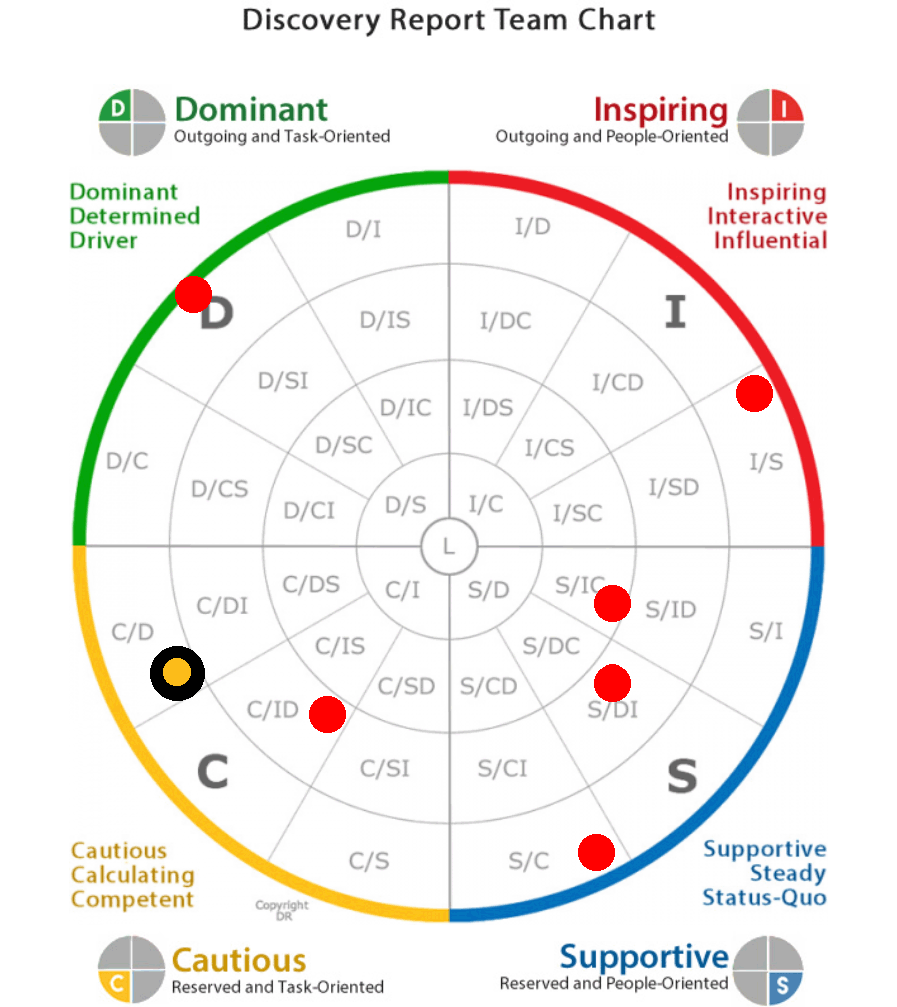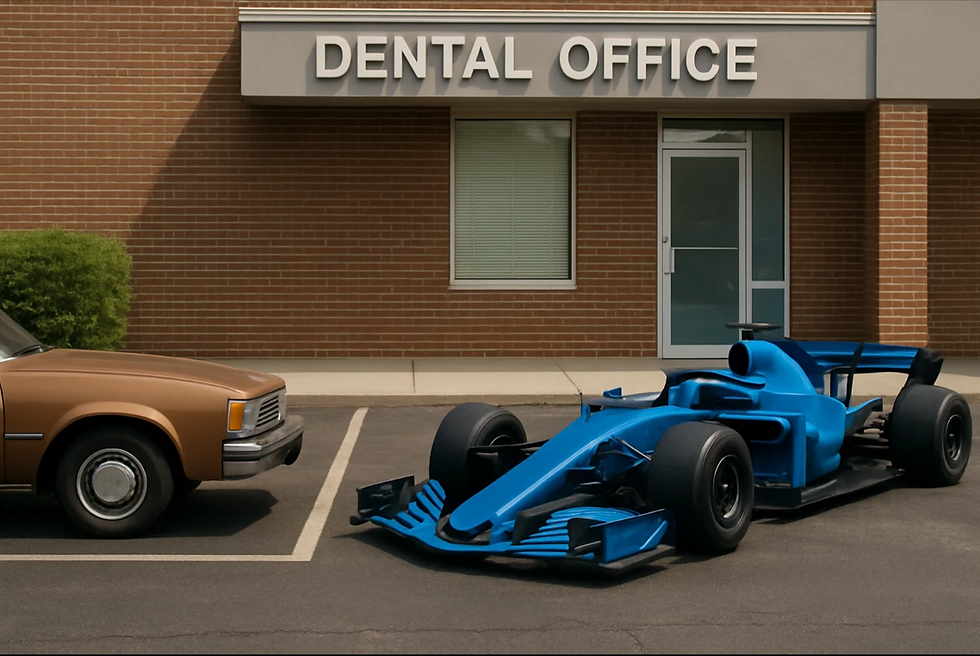How to Attract and Retain the Best Team: The DISC Advantage
- Randy LaFrom
- Jun 12
- 7 min read
By: Randall LaFrom, DDS
Modern dental practices aren't limited by technology or skills—they're struggling with people issues. Staffing shortages are rampant:[3] ~62% of dentists say recruiting is the top challenge for 2025, with 95% calling clinical and admin staffing shortages a significant problem.[1,2] Meanwhile, Gen Z and Millennials expect meaningful work, a strong company culture, opportunities for development, and the ability to maintain a healthy work-life balance.[4]
Every dental practice owner knows the frustration. You've invested in the latest technology and clinical training, yet communication breakdowns derail patient flow, staff morale dips, and case acceptance stalls. The missing piece isn't clinical—it's behavioral.
The DISC behavioral model offers a powerful solution. By aligning each team member's natural personality style with the right responsibilities, DISC turns chaotic offices into harmonized teams. DISC identifies four behavioral types—Dominance (D), Influence (I), Steadiness (S), and Conscientiousness (C)—and gives you tools to put people where they thrive. It's about behavioral alignment, not just job descriptions. Once you understand how your people are wired, everything changes—from hiring and retention to performance and patient care.

Hiring the right person for a dental role has never been just about experience or technical skill. It's about wiring. Did you hire someone who fits the behavioral demands of the position? The difference between burnout and breakthrough is rarely found in a resume—it's rooted in whether the role matches their core behavioral tendencies.
Smart Hiring with Behavioral Insights
Resumes may reveal experience and technical skills, but they don't reveal how someone behaves or connects with patients. Smart hiring begins with behavioral clarity. Here's how you might potentially use the DISC maps as they apply to key dental roles (acknowledging that additional training, implementing proven systems, and understanding of other behaviors are necessary, and most people express a combination of profiles):
Front Office (Receptionist, Scheduling Coordinator): You want someone warm, people-focused, and emotionally attuned. A high-I individual thrives here—someone who handles multitasking with a smile, makes patients feel instantly welcome, and remains upbeat. They set the tone within seconds of patient contact and guide patients toward optimal appointment scheduling.
Dental Assistant: This role demands steadiness and consistency. A high-S team member is loyal, calm, attentive, and incredibly dependable. They juggle patient comfort, clinical tools, and provider needs without chaos. Their quiet composure keeps the clinical engine running smoothly.
Hygienist: A strong hygienist blends independent motivation with precise communication. High-C or C/S combinations excel here. They're clinical educators, detail-driven, and self-starters who communicate with care. They require autonomy and thrive when given clarity, trust, and the necessary tools to educate effectively.
Office Manager: This is the symphony conductor. A high-D/C manager (tempered with people skills) brings assertiveness, strategic problem-solving, and operational structure. They don't just manage—they lead. High-D gets it done; High-C makes sure it's done right. They thrive on systems, responsibility, and decision-making authority.
DISC Tip: Attract the right style with the right words. Job descriptions are behavioral magnets. Want a High-C? Use "detail-oriented" or "organized." Want a High-I? Use "enthusiastic" or "people-loving."
Beyond the Hire: Retention Starts with Alignment
Even the best hires struggle in the wrong environment. DISC isn't just a hiring tool—it's your culture-building blueprint. Long-term retention depends on understanding how your team members prefer to be trained, coached, and managed.
Begin with onboarding that matches their behavioral style. High-S individuals need extra reassurance and clear explanations, while High-D types prefer independence and straightforward expectations from day one.
Create personalized check-ins at key milestones:
· 30 days: Do you understand the job?
· 60 days: Do you have all the tools and training you need?
· 90 days: Are you successfully performing the job?
Tailor each milestone to the individual's learning style and how they best integrate with the team.
Then, coach for growth, not control. High-I staff respond to enthusiastic feedback. High-C staff want structured, specific input. High-S staff value consistency and calm. High-D staff need clear goals and autonomy. The key is matching your management style to what each person needs to thrive. When teams are managed with behavioral fluency, stress drops and collaboration flourishes.
Culture Is the Real Differentiator
A DISC-informed culture creates an environment where behavioral awareness becomes part of daily operations:
Huddles using shared behavioral language
DISC visual boards reminding staff of each other's styles
Delegating tasks based on who naturally thrives in specific responsibilities
Using DISC to resolve tension without personalizing conflict
This behavioral fluency is professional, not manipulative. Some worry that adapting communication to someone's behavioral type feels inauthentic. But it's the opposite. It's respectful. Adjusting your tone, approach, or pace to someone's behavioral comfort zone shows care. In dentistry, where emotions run high, this behavioral agility leads to smoother workflows and stronger patient relationships.
Remember that adapting your behavior takes energy, especially when it's outside your natural style. While you can stretch to accommodate others, it requires effort. When team members make this effort to connect with different behavioral styles, acknowledge it. Recognizing when someone is stepping outside their comfort zone to communicate better shows you value their care and professionalism.
As mentioned before, the group culture can make all the difference in a practice.
By conducting DISC profiles, or updating your current team profiles on each team member, you gain a snapshot of their strengths and identify areas that need focus to address potential challenges.

The chart above illustrates a commonly found distribution of DISC personalities plotted out for a team interaction grid. It shows the office has team members in all four different quadrants.
During a hypothetical team meeting, if the Doctor is a high "C" (as represented above with the yellow dot with a black circle in the bottom yellow quadrant), starts rambling on about production numbers, procedures, or tray set-ups, KPIs, or statistics, the following might happen:
Your employee who is a high "D" might get impatient with meetings and perceived useless details. They want to know the point of the meeting and for you to use their time efficiently. They would appreciate a summary of all the information, possibly in the form of a chart, and then proceed.
Your employee, who is a high "I", might become bored while trying to remain enthusiastic during the meeting. They want you to listen to them, but be careful about getting sidetracked. Brief bullet points or a chart with stories might keep them engaged.
Your employee, who is a high "S" might feel left out if you don't appreciate their efforts on the team, and they get emotional if any criticism is given to anyone. They may want you to interlace the details with stories that show warmth or humor.
The High "C" Dentist appreciates on-time employees who pay attention to detail and are dependable. Just as a high "C" should consider modifying their approach to presenting in a meeting, the meeting leader should adapt to the preferred communication styles of the rest of the group.
Another profile we see in dental offices is the High "D" dentist. While meaning well, they often come across as overly confident, outspoken, rushed, and uncaring. While sounding more "bottom line" and business-like, they like to hear about results. Some of the other personality styles might find their approach to be a little harsh or insensitive. When this is a dominant group culture, these offices may struggle with high turnover and a stressful environment.
Leadership Starts with Self-Awareness
Every culture starts at the top. Leaders need to flex their own behavioral style. A High-D leader must slow down and listen with the intention of understanding. A High-I may need to stay focused. A High-S may need to speak up. A High-C will need to take action before everything's perfect and resist the urge to respond with "yes, but..." when presented with new ideas. When leadership demonstrates behavioral agility, the team tends to follow suit.
This mindset protects against burnout. If someone is constantly operating outside their behavioral zone—say, a steady High-S being pushed into high-pressure decision-making—it creates stress. But in a DISC-aware culture, you can talk about that. Adjustments are made, energy is protected, and teams stay in sync.
Group culture is shaped by the style of the leaders, the most prominent style within the group, the type of work the group undertakes, the historical culture of the group, the level of cohesion or tension within the group, and the group's goals and mission. Group culture has a significant impact on the behavior, attitudes, and satisfaction of each group member.
DISC Is a Profit Multiplier
The financial impact is significant:
Retaining one high-performing team member saves thousands in rehiring costs
Stronger behavioral alignment boosts patient interactions, increasing treatment acceptance
Less conflict and smoother workflows increase efficiency
When behavioral fluency becomes part of your practice DNA, your team becomes magnetic. You don't just keep good people—you attract more of them. Patients notice. Referrals increase. Growth becomes sustainable.
Call to Action: Build Your Behavioral Muscle
Whether you're discovering DISC for the first time or ready to refine your current system, now is the time to bring behavioral awareness to life. This isn't a one-time initiative—it's a cultural muscle that must be strengthened and reinforced over time.
At Dental MBA, we don't just hand you DISC charts—we partner with you and your leaders to embed DISC into your systems, leadership, hiring, onboarding, and team dynamics. By aligning your team and transforming theory into practice, your culture thrives.
In an industry driven by connections and trust, behavioral fluency is the not-so-secret sauce that sets your dental practice apart.
Book a consultation today to discover how a DISC-driven culture can unlock your practice's hidden potential—empowering your team to operate with harmony and purpose, attracting and retaining ideal patients, and driving profitability through trust and alignment.
-----
References:
62% cite staffing as top 2025 concern
https://adanews.ada.org/new-dentist/2025/march/staffing-shortages-top-expected-challenges-this-year/
95% face staffing shortages
Gen Z / Millennials expect purpose, coaching, and culture
7,000+ U.S. dental shortage zones




Comments